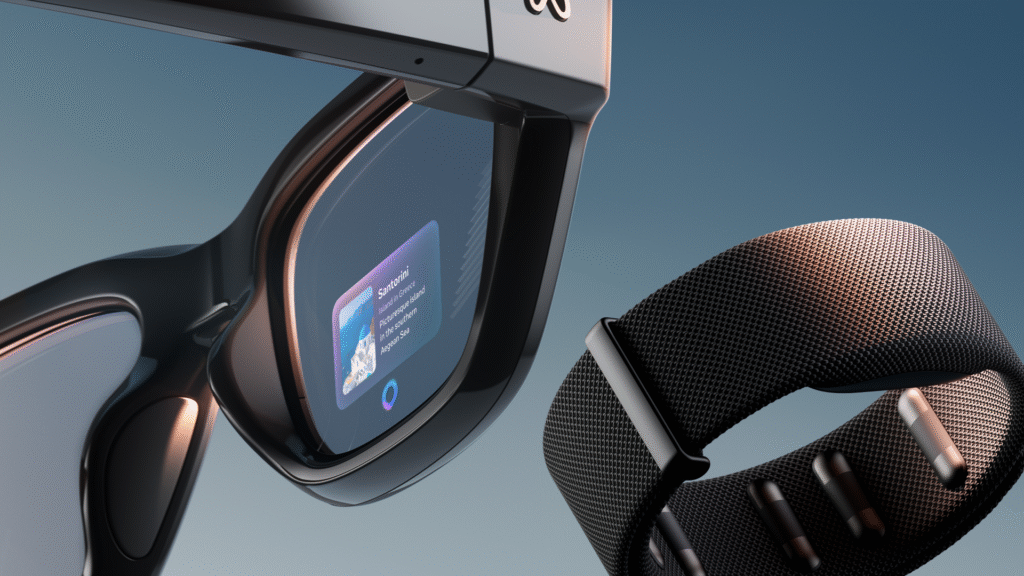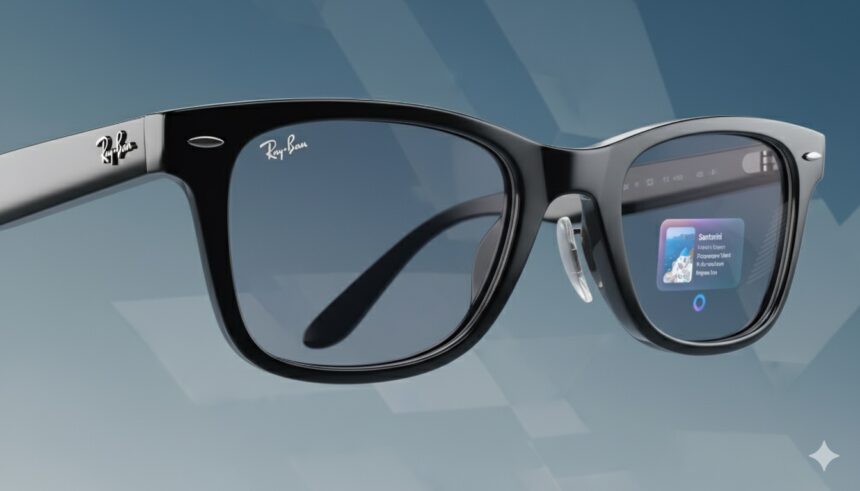Meta has announced a new addition to its wearable technology lineup: Ray-Ban smart glasses priced at $799, featuring a discreet built-in display and integrated artificial intelligence. The launch was revealed during Meta’s annual Connect event, marking a significant step toward the company’s vision of replacing smartphones with wearable devices.

Heads-Up, Not Heads-Down
The glasses are designed around a simple but ambitious idea: keep users connected without forcing them to look down at a phone. A tiny display embedded in the right lens projects notifications, calls, and contextual updates directly into the user’s line of sight. With voice commands powered by Meta AI, the glasses allow hands-free interaction for messaging, navigation, and quick information retrieval.
“Smartphones won’t disappear overnight, but we want to make technology fade into the background instead of dominating our attention,” said Meta Chief Technology Officer Andrew Bosworth during the presentation.
Gesture Controls and Everyday Design
Beyond the display, Meta has added gesture-based input. A lightweight wristband tracks subtle hand movements, such as pinching fingers together or swiping across the palm, letting users control music, answer calls, or summon Meta AI. The gesture system aims to deliver intuitive interaction without physical buttons or constant voice prompts.
The frames themselves are developed in partnership with Ray-Ban, continuing a design strategy that emphasizes style and familiarity. From the outside, the glasses resemble conventional eyewear, a deliberate choice to avoid the bulky, futuristic look that has hindered adoption of past AR devices.
📊 Meta Ray-Ban Display & Neural Band – Feature Summary
| Feature | Details |
|---|---|
| Display | Full-color, high-resolution in-lens display; visible on demand, positioned off to the side to avoid obstructing view. |
| AI Integration | Meta AI with visuals: provides step-by-step guides, translations, captions, and contextual help directly in the display. |
| Control Method | Meta Neural Band (EMG wristband) translates muscle signals into digital commands; supports scrolling, swiping, pinching, rotating, and eventually handwriting. |
| Communication | Hands-free messaging and video calls via WhatsApp, Messenger, and Instagram; private view of texts, photos, and Reels. |
| Camera & Media | Real-time viewfinder and zoom; preview, select, and share photos/videos through the display. |
| Navigation | Pedestrian navigation with turn-by-turn walking directions (beta in select cities). |
| Accessibility | EMG wristband works for people with limited mobility or tremors; detects subtle movements even before visible. |
| Live Captions & Translation | Real-time speech-to-text captions and language translation displayed on lens. |
| Music Playback | On-lens music card; control playback and volume via gestures on Neural Band. |
| Battery Life | Glasses: up to 6 hours of mixed use, 30 hours with charging case. Neural Band: up to 18 hours, IPX7 water-resistant. |
| Build & Comfort | Frames in Black or Sand; Transitions® lenses for indoor/outdoor use. Neural Band made with Vectran (used in Mars Rover crash pads). |
| Price & Availability | Starting at $799 USD (includes glasses + Neural Band). Launches Sept 30, 2025 in U.S. select retailers; expands to Canada, France, Italy, UK in 2026. |
| Product Positioning | Part of Meta’s three-tier AI glasses strategy: Camera AI glasses, Display AI glasses (Ray-Ban Display), and future AR glasses (Orion prototype). |
Why It Matters
Meta’s push into smart glasses reflects a broader race among tech giants to redefine personal computing. Apple’s Vision Pro headset has captured attention at the high-end, while Google continues to experiment with AR tools. By contrast, Meta is betting on subtlety and fashion—making advanced tech feel like a normal accessory rather than a gadget.
Industry analysts suggest the $799 price point positions the glasses between premium wearables and entry-level computing devices. If widely adopted, they could gradually reduce reliance on smartphones for quick tasks.
“Glasses are socially acceptable and always with you. If Meta can make the experience seamless, this could be the beginning of a shift in how we interact with digital tools,” said Priya Kapoor, a London-based tech consultant.
Challenges Ahead
Despite the excitement, hurdles remain. Battery life, display readability in bright sunlight, and privacy concerns around cameras and microphones have long plagued smart glasses. Meta has promised stronger privacy indicators, including LED lights that signal recording, but consumer trust may still take time to build.
Moreover, the glasses are currently limited in functionality compared to full-fledged smartphones. Analysts note that while they can handle notifications, music, and AI queries, they are not yet positioned to fully replace a phone.
Looking Forward
Meta has not yet shared international rollout details, but U.S. and European markets are expected to be first. For the company, success would reinforce its strategy of moving beyond social media into hardware and AI ecosystems.
For consumers, the launch raises an intriguing question: are we ready to wear our next phone on our face?
Check here more: https://about.fb.com/news/2025/09/meta-ray-ban-display-ai-glasses-emg-wristband/







